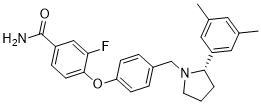This product is for research use only, not for human use. We do not sell to patients.

| Size | Price | Stock |
|---|---|---|
| 250mg | $1050 | In Stock |
| 500mg | $1750 | In Stock |
| 1g | $2625 | In Stock |
Cat #: V4911 CAS #: 1174130-61-0 Purity ≥ 98%
Description: Aticaprant (formerly also known as JNJ-67953964; LY-2456302; CERC501) is a novel, potent, oral, selective, CNS-penetrant and short-acting antagonist of the kappa / κ-opioid receptor (KOR) with a Ki of 0.807 nM (versus 24.0 nM and 155 nM for the μ-opioid receptor (MOR) and δ-opioid receptor (DOR).
Publications Citing InvivoChem Products
Product Promise

- Physicochemical and Storage Information
- Protocol
- Related Biological Data
- Stock Solution Preparation
- Quality Control Documentation
| Molecular Weight (MW) | 418.50 |
|---|---|
| Molecular Formula | C26H27FN2O2 |
| CAS No. | 1174130-61-0 |
| Storage | -20℃ for 3 years in powder formr |
| -80℃ for 2 years in solvent |
| Protocol | In Vitro | Aticaprant (CERC-501) binds with high affinity to the human kappa opioid receptor with a 30-fold higher affinity over the human mu opioid receptor and 190-fold higher affinity over the human delta opioid receptor. Aticaprant (CERC-501) shows no appreciable affinity for several non-opioid cell surface G-protein-coupled receptor targets, including monoaminergic, muscarinic, cholinergic, and adrenergic receptors or ion channel/transporter binding targets or the central benzodiazepine binding site |
|---|---|---|
| In Vivo | Aticaprant (CERC-501) has a rapid absorption (tmax=1-2 h) and good oral bioavailability (F=25%). Oral Aticaprant (CERC-501) administration selectively and potently occupies central kappa opioid receptors (ED50=0.33 mg/kg), without evidence of mu or delta receptor occupancy. LY2456302 potently blocks kappa-agonist-mediated analgesia and disruption of prepulse inhibition, without affecting mu-agonist-mediated effects at doses >30-fold higher. Aticaprant (CERC-501) produces antidepressant-like effects in the mouse forced swim test and enhances the effects of imipramine and citalopram. Aticaprant (CERC-501) reduces ethanol self-administration in alcohol-preferring rats |
| Solvent volume to be added | Mass (the weight of a compound) | |||
|---|---|---|---|---|
| Mother liquor concentration | 1mg | 5mg | 10mg | 20mg |
| 1mM | 2.3895 mL | 11.9474 mL | 23.8949 mL | 47.7897 mL |
| 5mM | 0.4779 mL | 2.3895 mL | 4.7790 mL | 9.5579 mL |
| 10mM | 0.2389 mL | 1.1947 mL | 2.3895 mL | 4.7790 mL |
| 20mM | 0.1195 mL | 0.5974 mL | 1.1947 mL | 2.3895 mL |
This equation is commonly abbreviated as: C1 V1 = C2 V2
- (1) Please be sure that the solution is clear before the addition of next solvent. Dissolution methods like vortex, ultrasound or warming and heat may be used to aid dissolving.
- (2) Be sure to add the solvent(s) in order.




































